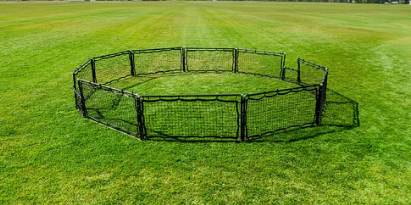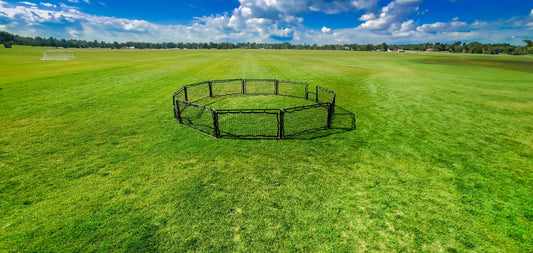Step up to the plate, fellow baseball aficionados! We're about to embark on a journey through the hallowed halls of baseball training equipment—a world where bats become magic wands, gloves transform into trusty sidekicks, and the humble ball takes on the role of a mischievous dance partner. As we dive into the arsenal of tools that turns rookies into rockstars and pros into legends, prepare for a grand slam of innovation, a curveball of wit, and a fastball of fun. So, dust off your cleats, adjust your cap, and get ready to knock it out of the park because, in this diamond of delights, every swing is a step closer to baseball greatness!

Baseball is a bat-and-ball game played between two teams, each consisting of nine players. It is widely regarded as America's national pastime and has a rich history dating back to the 18th century. The game is played on a diamond-shaped field with bases at its corners, and the objective is for a player to hit a pitched ball and then run around the bases to score runs.
Key Elements of Baseball:
- The Field:
- A baseball field is traditionally diamond-shaped, with four bases: first, second, third, and home plate. The bases are arranged in a square, and the distance between them is 90 feet.
- Positions:
- Each team has nine players on the field, each with specific positions, including pitcher, catcher, infielders (first baseman, second baseman, shortstop, and third baseman), and outfielders (left fielder, center fielder, and right fielder).
- The Pitcher:
- The pitcher stands in the center of the diamond on the pitcher's mound and throws the ball towards home plate. The pitcher's primary goal is to prevent the batter from hitting the ball.
- Batting:
- The batter stands in the batter's box next to home plate and attempts to hit the pitched ball. A successful hit allows the batter to become a base runner.
- Baserunning:
- Baserunners move counter-clockwise around the bases. They can advance by running when the pitcher pitches the ball or when a teammate gets a hit. The objective is to score by touching home plate.
- Scoring Runs:
- A run is scored when a baserunner successfully advances around all four bases and touches home plate. The team with the most runs at the end of the game is declared the winner.
- Innings:
- A standard baseball game consists of nine innings, with each team taking turns playing offense and defense. The team with the most runs at the end of nine innings wins. Extra innings are played in the case of a tie.
- Outs:
- An out occurs when the defensive team successfully retires a batter or baserunner. There are three outs in each half-inning.
- Defense:
- The defensive team attempts to get outs by catching the ball before it hits the ground, throwing the ball accurately to retire baserunners, and making strategic plays to prevent the opposing team from scoring.
- Equipment:
- Baseball equipment includes a bat for hitting, a glove for fielding, a helmet for batters, and protective gear for catchers. The ball used in baseball is a hard sphere covered in leather.
- Leagues and Tournaments:
- Baseball is played at various levels, from amateur and youth leagues to professional leagues such as Major League Baseball (MLB) in the United States. International competitions, including the World Baseball Classic, showcase the global appeal of the sport.
Baseball is cherished for its mix of strategy, skill, and athleticism. It has become deeply ingrained in the cultural fabric of many countries, and its enduring popularity makes it one of the most beloved sports around the world.
Below we are going to discuss some different types of equipment and how they can assist in your baseball skills.
Rebounders

While rebounders are more commonly associated with soccer and other sports, they can be adapted for use in baseball training to enhance specific skills. Here's how rebounders can assist in baseball training:
- Pitching Accuracy:
- Rebounders can be used as targets for pitchers to improve their accuracy. Pitchers can aim for specific areas on the rebounder, helping them focus on hitting their spots consistently.
- Catching and Fielding:
- Fielders, especially catchers and infielders, can use rebounders to simulate ground balls or line drives. The rebounder can provide unpredictable bounces, challenging fielders to react quickly and practice their catching and fielding skills.
- Throwing and Arm Strength:
- Outfielders or players in other positions can use rebounders to practice throwing with accuracy and strength. Players can throw the ball into the rebounder, mimicking the return of a hit or a throw to a specific base.
- Hand-Eye Coordination:
- Hitters can use rebounders to work on hand-eye coordination. By hitting balls into the rebounder, batters can improve their timing and ability to make contact with the ball.
- Infield Drills:
- Rebounders can be integrated into infield drills, providing players with a dynamic target to field ground balls. The unpredictable rebound from the surface challenges infielders to stay low, use proper fielding techniques, and react quickly.
- Reaction Training:
- The rebounder's unpredictable bounces can be utilized for reaction training. Players, whether fielders or hitters, must react quickly to the ball's return, helping them improve their reflexes and adaptability.
- Solo Training:
- Rebounders allow players to engage in solo training sessions. This is particularly beneficial for players who want to work on specific skills outside of team practices. Players can use the rebounder to get extra reps on various aspects of their game.
- Bunting Practice:
- Bunters can use rebounders to practice their bunting technique. The rebounder can simulate different angles and distances, allowing bunters to refine their ability to place the ball strategically.
- Dynamic Warm-Ups:
- Rebounders can be incorporated into dynamic warm-up routines. Players can throw or hit balls into the rebounder to get their bodies and muscles warmed up before more intensive training activities.
- Fun and Engaging Drills:
- Incorporating rebounders into drills adds an element of fun and engagement to training sessions. Players enjoy the challenge of dealing with the unpredictable rebounds, making the training experience more dynamic.
While not as commonly used in baseball as in some other sports, the versatility of rebounders allows for creative adaptations in baseball training, offering players an opportunity to hone various skills in an interactive and challenging environment. Try our nets that can be used as rebounders from us here at Castle Sports.
Batting Tee
A batting tee is a fundamental and versatile tool in baseball training, particularly for hitters. Here's how a batting tee assists in baseball training:
- Fundamental Hitting Mechanics:
- Batting tees are essential for teaching and reinforcing fundamental hitting mechanics. They allow players to focus on their stance, grip, and swing without the distraction of a moving ball or the pressure of live pitching.
- Hand-Eye Coordination:
- Hitters use a batting tee to improve hand-eye coordination. By consistently making contact with the stationary ball, players refine their ability to track the ball and time their swings accurately.
- Consistent Repetition:
- Batting tees provide a consistent and repeatable hitting experience. Players can take numerous swings in a short amount of time, allowing for concentrated repetition of specific aspects of their swing.
- Hitting Zones and Angles:
- Players can adjust the height and placement of the batting tee to focus on hitting pitches in different zones and at various angles. This helps hitters develop a well-rounded approach to hitting in different parts of the strike zone.
- Isolation of Swing Components:
- Hitters can isolate and work on specific components of their swing, such as load, stride, and follow-through. This level of focus is challenging to achieve in live batting situations.
- Targeted Drills:
- Coaches can design targeted drills using a batting tee to address specific areas of a player's swing or to work on hitting to different parts of the field.
- Pitch Recognition:
- While the ball is stationary on the tee, players can practice recognizing different pitches by adjusting the tee's placement and simulating pitches in various locations.
- Solo Training:
- Hitters can use a batting tee for solo training sessions, allowing them to work on their swing mechanics independently. This is particularly valuable for players looking to get extra practice outside of team sessions.
- Visual Feedback:
- The immediate visual feedback of hitting a ball off a tee helps players assess the quality of their contact and adjust their technique accordingly.
- Warm-Up Tool:
- Batting tees are useful as warm-up tools before live batting practice or games. Players can start with tee work to groove their swings before facing live pitching.
- Versatility:
- Batting tees are versatile and can be used for various hitting drills, making them suitable for players of all ages and skill levels. They are a staple in both youth and professional baseball training.
- Reduced Injury Risk:
- Hitting off a tee reduces the risk of injury compared to live pitching, allowing players to focus on their mechanics without the added stress of high-velocity pitches.
In summary, a batting tee is an indispensable tool in baseball training, offering a controlled and focused environment for players to refine their hitting mechanics, hand-eye coordination, and overall offensive skills. It provides a solid foundation for hitters to build upon as they progress in their baseball development.
Pitching machine
A pitching machine is a valuable tool in baseball training, serving various purposes to help players develop their skills. Here's how a pitching machine assists in baseball training:
- Consistent Pitches:
- Pitching machines deliver consistent and repeatable pitches, allowing hitters to practice against a steady stream of pitches. This consistency is crucial for players to develop muscle memory and improve their ability to make solid contact.
- Varied Pitch Types:
- Advanced pitching machines can throw different types of pitches, including fastballs, curveballs, sliders, and change-ups. This versatility enables hitters to practice against a variety of pitches and prepares them for different game situations.
- Adjustable Speeds:
- Pitching machines typically have adjustable speeds, allowing coaches to tailor the pitch velocity to the skill level of the players. Beginners can start with slower pitches, while more advanced players can challenge themselves with faster speeds.
- Targeted Pitch Locations:
- Coaches can set pitching machines to throw pitches to specific locations within the strike zone. This helps hitters work on targeting different areas and improves their ability to adjust to pitches in different locations.
- Solo Training:
- Players can use pitching machines for solo training sessions. This independence allows players to get extra reps and work on specific aspects of their hitting without needing a pitcher.
- Consistent Timing Practice:
- Hitters can use pitching machines to practice timing their swings consistently. The machine's regular rhythm allows players to focus on their load, stride, and swing mechanics without the variable timing of a human pitcher.
- Increased Repetition:
- Pitching machines enable players to take a high volume of swings in a short period, maximizing repetition and helping hitters refine their mechanics through consistent practice.
- Game-Like Situations:
- By simulating realistic pitching scenarios, pitching machines prepare players for game-like situations. This includes facing different pitch types, adjusting to varying speeds, and developing the ability to recognize and react to pitches quickly.
- Injury Prevention:
- Hitters can practice against pitching machines without the physical toll that can come from live pitching. This can be especially important for young players or those returning from injuries, as it reduces the risk of overuse.
- Fielding and Catching Practice:
- Pitching machines can be adjusted to throw ground balls or pop flies, allowing players to work on fielding and catching skills for both infielders and outfielders.
- Team Drills:
- Pitching machines facilitate team drills, enabling multiple players to take turns hitting in a controlled and efficient manner. This is particularly useful for team practices where time and resources are limited.
- Quick Adjustment for Drills:
- Coaches can quickly adjust pitching machines for different drills, making them versatile tools for various aspects of baseball training, including hitting, fielding, and baserunning.
In summary, a pitching machine is an essential component of baseball training, providing a controlled and customizable environment for players to hone their hitting skills and prepare for the challenges of live game situations.

As the final swing echoes through the training ground and the last pitch meets the mitt, the symphony of baseball training equipment fades into a crescendo of progress and dedication. From the crack of the bat against the tee to the rhythmic thud of balls against the rebounder, each piece of equipment has played its part in sculpting players into well-rounded athletes. As the dust settles on the diamond, the legacy of countless swings, catches, and pitches lingers—a testament to the unwavering pursuit of excellence in the world of baseball. So, let the gloves be oiled, the bats be rested, and the fields await the next inning of drills, practices, and victories. Until the next session, may the pop of the mitt and the crack of the bat resonate, echoing the timeless spirit of the game we all hold dear. Play ball!







